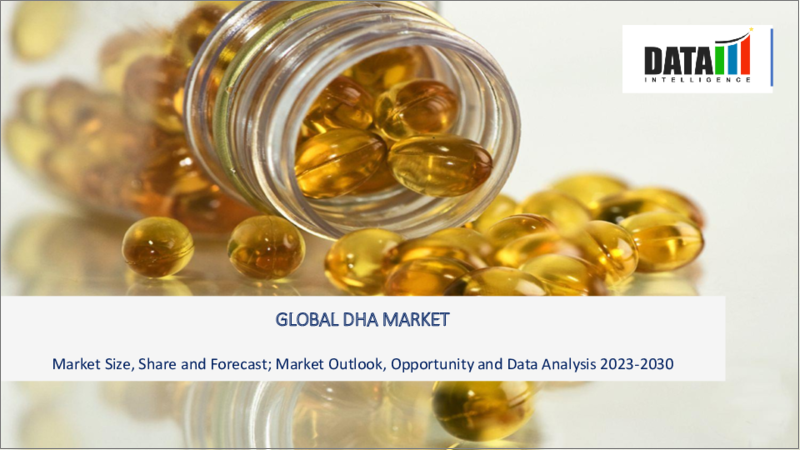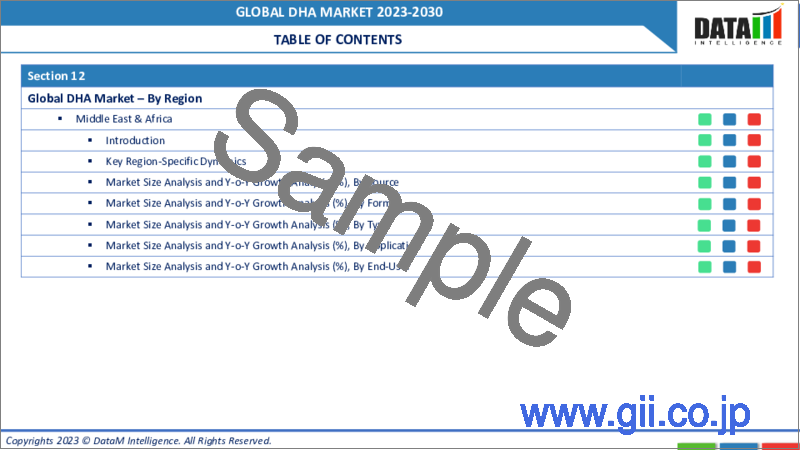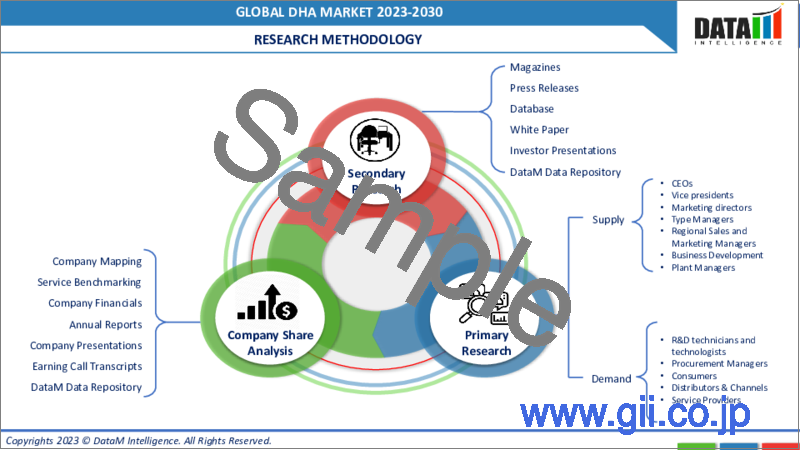|
|
市場調査レポート
商品コード
1316257
DHAの世界市場-2023年~2030年Global DHA Market - 2023-2030 |
||||||
カスタマイズ可能
適宜更新あり
|
|||||||
| DHAの世界市場-2023年~2030年 |
|
出版日: 2023年07月27日
発行: DataM Intelligence
ページ情報: 英文 190 Pages
納期: 即日から翌営業日
|
- 全表示
- 概要
- 目次
市場概要
DHAの世界市場は2022年に7億8,020万米ドルに達し、2030年には11億950万米ドルに達すると予測され、予測期間2023-2030年のCAGRは4.5%で成長すると予測されています。DHA市場成長の主な促進要因は、その健康効果にあります。ある研究では、DHAを摂取すると関節リウマチの症状が28%軽減しました。炎症と心臓病は関連しているため、炎症を抑えることで冠動脈イベントのリスクも低下する可能性があります。
ドコサヘキサエン酸は、健康志向の人々の増加により、様々な業界で頻繁に使用されるようになっています。ドコサヘキサエン酸は世界的に消費量が増加しており、市場の拡大を促進しています。ドコサヘキサエン酸は、病気の予防や治療において様々な利点があるため、その使用と生産が拡大しています。
ドコサヘキサエン酸市場は、毎日の食事における健康補助食品の使用量の増加から全体として利益を得ています。世界のドコサヘキサエン酸市場の成長の主な障壁は、適切な代替品の不足です。さらに、口臭、悪味、頭痛などのような否定的な副作用が、ドコサヘキサエン酸ベースの商品の使用を思いとどまらせています。
市場力学
世界のドコサヘキサエン酸市場は、その健康上の利点別牽引されています
DHAは多くの健康上の利点と関連しています。脳内のDHAレベルは年齢とともに低下することが知られており、散発性アルツハイマー病の発症に関連しています。心血管疾患は西側諸国における主な死亡原因となっています。2021年のWHOの報告書によると、心血管疾患(CVD)は年間推定1,790万人の命を奪っており、世界中で主な死亡原因となっています。
冠動脈性心疾患、脳血管疾患、リウマチ性心疾患、その他の病気は、CVDとして知られる心臓や血管の疾患の範疇に含まれます。CVDによる死亡者の5人に4人以上が心臓発作と脳卒中であり、その3分の1が70歳までに死亡しています。心臓疾患の蔓延により、消費者はDHAサプリメントを選ぶようになっており、これがDHA市場の成長を牽引しています。
授乳中の母親や妊婦の間で高まるDHAの重要性
妊娠中または授乳中の女性は、少なくとも1日200mgのDHAを摂取すべきです。最近の研究によると、現在の摂取量は少なすぎる可能性があります。Stoutjesdijkらによると、新生児が最適な濃度のLCPUFAを摂取できるようにするためには、女性は妊娠第3期には1日あたり535+215mgのDHA+EPAを、授乳中の最初の1ヵ月には1日あたり715+285mgのDHA+EPAを摂取すべきです。
重要なことは、これらの量のLCPUFAを摂取するには、毎週必要な10オンス(2~3食)の魚を食べればよいということです。しかし、多くのアメリカ人はそれほど魚を摂取していないです。アメリカ人の1週間の平均摂取量はわずか4オンスで、推奨量の半分以下です。
DHAの過剰摂取は多くの健康問題を引き起こし、これが市場成長の妨げとなっています
DHAには抗炎症作用があり、これが炎症や心臓の健康に良いとされる理由の一つです。しかし、研究者らは、過剰なDHAは時として免疫機能を変化させ、細菌やウイルス感染に対する効果的な免疫反応を引き起こしかねないと指摘しています。細菌のような微生物感染と闘う身体の能力は、DHAの過剰摂取によって正常に機能しない免疫系によって影響を受ける可能性があります。
COVID-19影響分析
COVID-19分析には、COVID前シナリオ、COVIDシナリオ、COVID後シナリオに加え、価格力学(COVID前シナリオと比較したパンデミック中およびパンデミック後の価格変動を含む)、需給スペクトラム(取引制限、封鎖、およびその後の問題による需要と供給のシフト)、政府の取り組み(政府機関による市場、セクター、業界を復興させる取り組み)、メーカーの戦略的取り組み(COVID問題を緩和するためにメーカーが行った取り組み)が含まれます。
目次
第1章 調査手法と調査範囲
第2章 市場の定義と概要
第3章 エグゼクティブサマリー
第4章 市場力学
- 市場への影響要因
- 促進要因
- 抑制要因
- 機会
- 影響分析
第5章 産業分析
- ポーターのファイブフォース分析
- サプライチェーン分析
- 価格分析
- 規制分析
第6章 COVID-19分析
第7章 供給源
- 藻類油
- 魚油
- クリルオイル
- その他
第8章 用途別
- 医薬品
- 動物飼料
- 機能性飲食品
- 化粧品
- その他
第9章 エンドユーザー別
- 乳幼児
- 小児および成人
- 授乳中の母親と妊婦
- その他
第10章 地域別
- 北米
- 米国
- カナダ
- メキシコ
- 欧州
- ドイツ
- 英国
- フランス
- イタリア
- スペイン
- その他欧州
- 南米
- ブラジル
- アルゼンチン
- その他南米
- アジア太平洋
- 中国
- インド
- 日本
- オーストラリア
- その他アジア太平洋地域
- 中東・アフリカ
第11章 競合情勢
- 競合シナリオ
- 市況/シェア分析
- M&A分析
第12章 企業プロファイル
- BASF SE
- 会社概要
- 製品ポートフォリオと説明
- 財務概要
- 主な発展
- Clover Corporation
- Croda Inc.
- Nordic Naturals
- Omega Protein Corporation
- DSM N.V.
- Cargill, Incorporated.
- Copeinica
- Epax
- Givaudan
第13章 付録
Market Overview
Global DHA Market reached US$ 780.2 million in 2022 and is expected to reach US$ 1,109.5 million by 2030 and is expected to grow with a CAGR of 4.5% during the forecast period 2023-2030. The primary driver for DHA market growth is owing to its health benefits. In a study, eating DHA reduced rheumatoid arthritis symptoms by 28%. Since inflammation and heart disease are related, reducing inflammation may also reduce your risk of coronary events.
Docosahexaenoic acid is being used more frequently across a variety of industries as a result of the rise in the number of health-conscious people. Docosahexaenoic acid is increasingly being consumed globally, which is fostering market expansion. Because of the multiple advantages it offers in terms of disease prevention and treatment, docosahexaenoic acid use and production have expanded.
The market for docosahexaenoic acid as a whole benefit from the rising usage of health supplements in daily diet. The primary barrier to growth in the worldwide docosahexaenoic acid market is the lack of suitable replacements. Furthermore, negative side effects like foul breath, bad taste, headaches, and others discourage people from using docosahexaenoic acid-based goods.
Market Dynamics
The Global Docosahexaenoic Acid Market is Being Driven by its Health Benefits.
DHA is associated with plenty of health benefits. DHA levels in the brain are known to decrease with age and are linked to the start of sporadic Alzheimer's disease. Cardiovascular disease is the main killer in Western countries. Cardiovascular diseases (CVDs), which claim an estimated 17.9 million lives annually, are the leading cause of mortality worldwide, according to the WHO report 2021.
Coronary heart disease, cerebrovascular disease, rheumatic heart disease, and other illnesses are among the category of heart and blood vessel disorders known as CVDs. Heart attacks and strokes account for more than four out of every five CVD deaths, and one-third of these deaths happen before the age of 70. Due to the prevalence of heart diseases, consumers are opting for DHA supplements, which is driving the DHA market growth.
Growing Importance of DHA among Breastfeeding Mothers and Pregnant Women
Women who are expecting or nursing should take at least 200 mg of DHA daily. The current suggestion may be too low, according to a recent study. According to Stoutjesdijk et al., women should eat 535 + 215mg DHA+EPA per day during the third trimester and 715 + 285mg DHA+EPA per day during the first month of breastfeeding in order to ensure that the newborn has access to the optimum concentrations of LCPUFAs.
Importantly, obtaining these amounts of LCPUFAs can be accomplished simply by eating the necessary 10 oz (2-3 meals) of fish each week. However, not many Americans consume as much fish. The weekly average for Americans is only 4 oz, which is less than half the advised quantity.6 Additionally, the most popular types are low in LCPUFAs.
The Overconsumption of DHA Leads to Many Health Issues, which is Hindering the Market Growth.
DHA has anti-inflammatory characteristics, which is one of the reasons it may be good for inflammation and heart health. However, the researchers noted that excessive DHA can occasionally change immune function in ways that may cause an ineffective immune response to a bacterial or viral infection. The body's capacity to combat microbial infections like bacteria can be impacted by an immune system that isn't functioning properly due to excessive DHA ingestion.
COVID-19 Impact Analysis
The COVID-19 Analysis includes Pre-COVID Scenario, COVID Scenario and Post-COVID Scenario along with Pricing Dynamics (Including pricing change during and post-pandemic comparing it with pre-COVID scenarios), Demand-Supply Spectrum (Shift in demand and supply owing to trading restrictions, lockdown and subsequent issues), Government Initiatives (Initiatives to revive market, sector or Industry by Government Bodies) and Manufacturers Strategic Initiatives (What manufacturers did to mitigate the COVID issues will be covered here).
Segment Analysis
The global DHA market is segmented based on source, application, end-user, and region.
In the Global Market of DHA, the Pharmaceuticals of Application Segment Holds the Largest Market Share.
The global DHA market has been segmented by application into animal feed, pharmaceuticals, functional food and beverages, cosmetics, and others. The pharmaceuticals segment held the largest DHA market share of 42.8% in 2022 in the DHA market analysis report. Dietary supplements, infant formula, and maternal nutrition are the wide applications of DHA in the pharmaceutical industry.
DHA is essential for the growth of nerve and ocular structures. By reducing blood thickness, inflammation, and lipid levels in circulation, DHA may help minimize the chance of developing vision health, cognitive development, and circulatory disease. DHA is frequently used by people to treat high blood fat or cholesterol levels. Additionally, it is used to improve memory and cognitive abilities, assist newborn and child development, treat some eye diseases, and treat a variety of other ailments.
Geographical Analysis
The Asia-Pacific Region Held the Largest Share in DHA Market.
The global DHA market is segmented into five parts of the world based on geography: North America, South America, Europe, Asia Pacific, the Middle East, and Africa. The Asia-Pacific DHA market held the largest market share of 32.6% in 2022 in the DHA market analysis. The demand in the region is anticipated to increase as consumers become more aware of the advantages of consuming DHA supplements.
Customers in this region choose to consume DHA-rich fish in their diets over items made from algae. As a result, food producers do not believe it is worthwhile to increase production costs by substituting pricey algal omega-3 fatty acids components for ones derived from fish. Due to rising knowledge of the critical role that DHA plays in brain development and other essential processes, there has also been an increase in the demand among youngsters to meet their essential nutritional needs.
Competitive Landscape
The major global players in the market include: BASF SE, Clover Corporation, Croda Inc., Nordic Naturals, Omega Protein Corporation, DSM N.V., Cargill, Incorporated., Copeinica, Epax, and Givaudan.
Global Recession/Ukraine-Russia War/COVID-19, and Artificial Intelligence Impact Analysis:
COVID-19 Impact:
The DHA market was significantly impacted by COVID-19. During the epidemic, consumer purchasing habits altered. This resulted from a rise in consumer demand in wholesome, nutritious meals. Because consuming these goods improves physical and mental health, DHA-containing products are among the top choices of customers. For instance, one of the major competitors in this market, Archer Daniels Midland Company, predicted a rise of 76% in the first quarter of fiscal 2021.
The market is expanding as a result of factors like growing consumer knowledge of the health advantages of DHA. As more people live longer, the industry is likewise becoming more significant and a component of consumers' regular diets.
Why Purchase the Report?
- To visualize the global DHA market segmentation based on source, application, end-user, and region, as well as understand key commercial assets and players.
- Identify commercial opportunities in the market by analyzing trends and co-development.
- Excel data sheet with numerous data points of DHA market-level with all segments.
- The PDF report consists of cogently put-together market analysis after exhaustive qualitative interviews and in-depth market study.
- Product mapping is available as Excel consists of key products of all the major market players.
The global DHA market report would provide approximately 61 tables, 61 figures, and 190 Pages.
Target Audience 2023
- Manufacturers/ Buyers
- Industry Investors/Investment Bankers
- Research Professionals
- Emerging Companies
Table of Contents
1. Methodology and Scope
- 1.1. Research Methodology
- 1.2. Research Objective and Scope of the Report
2. Market Definition and Overview
3. Executive Summary
- 3.1. Market Snippet, by Source
- 3.2. Market Snippet, by Application
- 3.3. Market Snippet, by End-User
- 3.4. Market Snippet, by Region
4. Market Dynamics
- 4.1. Market Impacting Factors
- 4.1.1. Drivers
- 4.1.2. Restraints
- 4.1.3. Opportunity
- 4.1.4. Impact Analysis
5. Industry Analysis
- 5.1. Porter's Five Force Analysis
- 5.2. Supply Chain Analysis
- 5.3. Pricing Analysis
- 5.4. Regulatory Analysis
6. COVID-19 Analysis
- 6.1. Analysis of COVID-19 on the Market
- 6.1.1. Scenario Before COVID-19
- 6.1.2. Scenario During COVID-19
- 6.1.3. Scenario Post COVID-19
- 6.2. Pricing Dynamics Amid COVID-19
- 6.3. Demand-Supply Spectrum
- 6.4. Government Initiatives Related to the Market During Pandemic
- 6.5. Manufacturers Strategic Initiatives
- 6.6. Conclusion
7. Source
- 7.1. Introduction
- 7.1.1. Market Size Analysis and Y-o-Y Growth Analysis (%), By Source
- 7.1.2. Market Attractiveness Index, By Source
- 7.2. Algae Oil
- 7.2.1. Introduction
- 7.2.2. Market Size Analysis and Y-o-Y Growth Analysis (%)
- 7.3. Fish Oil
- 7.4. Krill Oil
- 7.5. Others
8. By Application
- 8.1. Introduction
- 8.1.1. Market Size Analysis and Y-o-Y Growth Analysis (%), By Application
- 8.1.2. Market Attractiveness Index, By Application
- 8.2. Pharmaceuticals
- 8.2.1. Introduction
- 8.2.2. Market Size Analysis and Y-o-Y Growth Analysis (%)
- 8.3. Animal Feed
- 8.4. Functional Food and Beverages
- 8.5. Cosmetics
- 8.6. Others
9. By End-User
- 9.1. Introduction
- 9.1.1. Market Size Analysis and Y-o-Y Growth Analysis (%), By End-User
- 9.1.2. Market Attractiveness Index, By End-User
- 9.2. Infants
- 9.2.1. Introduction
- 9.2.2. Market Size Analysis and Y-o-Y Growth Analysis (%)
- 9.3. Children and Adults
- 9.4. Breastfeeding Mothers and Pregnant Women
- 9.5. Others
10. By Region
- 10.1. Introduction
- 10.1.1. Market Size Analysis and Y-o-Y Growth Analysis (%), By Region
- 10.1.2. Market Attractiveness Index, By Region
- 10.2. North America
- 10.2.1. Introduction
- 10.2.2. Key Region-Specific Dynamics
- 10.2.3. Market Size Analysis and Y-o-Y Growth Analysis (%), By Source
- 10.2.4. Market Size Analysis and Y-o-Y Growth Analysis (%), By Application
- 10.2.5. Market Size Analysis and Y-o-Y Growth Analysis (%), By End-User
- 10.2.6. Market Size Analysis and Y-o-Y Growth Analysis (%), By Country
- 10.2.6.1. The U.S.
- 10.2.6.2. Canada
- 10.2.6.3. Mexico
- 10.3. Europe
- 10.3.1. Introduction
- 10.3.2. Key Region-Specific Dynamics
- 10.3.3. Market Size Analysis and Y-o-Y Growth Analysis (%), By Source
- 10.3.4. Market Size Analysis and Y-o-Y Growth Analysis (%), By Application
- 10.3.5. Market Size Analysis and Y-o-Y Growth Analysis (%), By End-User
- 10.3.6. Market Size Analysis and Y-o-Y Growth Analysis (%), By Country
- 10.3.6.1. Germany
- 10.3.6.2. The U.K.
- 10.3.6.3. France
- 10.3.6.4. Italy
- 10.3.6.5. Spain
- 10.3.6.6. Rest of Europe
- 10.4. South America
- 10.4.1. Introduction
- 10.4.2. Key Region-Specific Dynamics
- 10.4.3. Market Size Analysis and Y-o-Y Growth Analysis (%), By Source
- 10.4.4. Market Size Analysis and Y-o-Y Growth Analysis (%), By Application
- 10.4.5. Market Size Analysis and Y-o-Y Growth Analysis (%), By End-User
- 10.4.6. Market Size Analysis and Y-o-Y Growth Analysis (%), By Country
- 10.4.6.1. Brazil
- 10.4.6.2. Argentina
- 10.4.6.3. Rest of South America
- 10.5. Asia-Pacific
- 10.5.1. Introduction
- 10.5.2. Key Region-Specific Dynamics
- 10.5.3. Market Size Analysis and Y-o-Y Growth Analysis (%), By Source
- 10.5.4. Market Size Analysis and Y-o-Y Growth Analysis (%), By Application
- 10.5.5. Market Size Analysis and Y-o-Y Growth Analysis (%), By End-User
- 10.5.6. Market Size Analysis and Y-o-Y Growth Analysis (%), By Country
- 10.5.6.1. China
- 10.5.6.2. India
- 10.5.6.3. Japan
- 10.5.6.4. Australia
- 10.5.6.5. Rest of Asia-Pacific
- 10.6. Middle East and Africa
- 10.6.1. Introduction
- 10.6.2. Key Region-Specific Dynamics
- 10.6.3. Market Size Analysis and Y-o-Y Growth Analysis (%), By Source
- 10.6.4. Market Size Analysis and Y-o-Y Growth Analysis (%), By Application
- 10.6.5. Market Size Analysis and Y-o-Y Growth Analysis (%), By End-User
11. Competitive Landscape
- 11.1. Competitive Scenario
- 11.2. Market Positioning/Share Analysis
- 11.3. Mergers and Acquisitions Analysis
12. Company Profiles
- 12.1. BASF SE
- 12.1.1. Company Overview
- 12.1.2. Product Portfolio and Description
- 12.1.3. Financial Overview
- 12.1.4. Key Developments
- 12.2. Clover Corporation
- 12.3. Croda Inc.
- 12.4. Nordic Naturals
- 12.5. Omega Protein Corporation
- 12.6. DSM N.V.
- 12.7. Cargill, Incorporated.
- 12.8. Copeinica
- 12.9. Epax
- 12.10. Givaudan
LIST NOT EXHAUSTIVE
13. Appendix
- 13.1. About Us and Services
- 13.2. Contact Us





